August 2010 Archives
 2010 100 Years of Australian Coinage Silver privymark $1
2010 100 Years of Australian Coinage Silver privymark $1The Royal Australian Mint has this year chosen to pre-strike a silver proof coin for each ANDA (Australian Numismatic Dealers Association) coin show held around the country in 2010.
This coin is a 100 Years of Australian Coinage One dollar struck in 99.99% fine silver proof. Each coin is struck with a special privymark. This particular privymark a letter over a kangaroo inside a square -seen below is an S and M over a kangaroo inside a square. Sydney, Brisbane, Melbourne and Perth, S, B, M and P privymarked coins have been released so far at each event. Mintage is 2,000 coins per show.
The Canberra ANDA show proved to be little different with the RAM attending with their portable press to strike an uncirculated C Counterstamp issue. A silver proof was also released but was a C Master Mint mark and not a privy mark. This just means that the square did not surround the kangaroo inside the 'C'.
To see the mintages of other similar issues, check the 2010 Mintage Table.
 Closeup of the S privymark from the Sydney ANDA Show
Closeup of the S privymark from the Sydney ANDA Show Closeup of the M privymark from the Melbourne ANDA Show
Closeup of the M privymark from the Melbourne ANDA Show
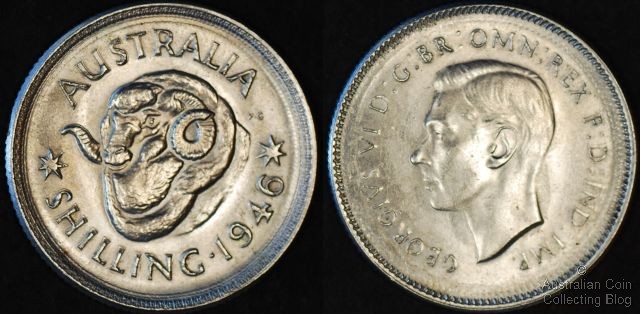 1946 Shilling Double Struck
1946 Shilling Double StruckCompared with how many coins are minted in a production run, the rate of error is quite small. We've spoken about double errors before and they are very rare coins to have in your collection.
The coin shown is a very interesting example. On first glance it looks like it may have been tampered with to produce the features that is has such as a wide flat flan and distorted lettering.
On closer inspection this however is not the case. This 1946 shilling was struck as any coin would be. The coin failed to exit the press but was pushed up out of the collar. It was struck again, this time out of the collar. Now it was this second strike that did the damage and left the clues to how this coin was made. There is edge milling present indicating it was once struck within the collar as normal. The rim beads show evidence of being smeared outwards when the coin was struck out of the collar which has resulted in the pancake like flan typical of an out of collar strike.
The ram and portrait are well struck with no damage further disagreeing with with any post mint damage scenario. The legends are however a different story. The reverse shows clear doubling of the letters indicating the second strike at a very slight rotation. The obverse shows distortion to the lettering this time making them thinner, the second strike obliterated the width to the letters because of the slight rotation. This is a common indicator of a double struck coin.
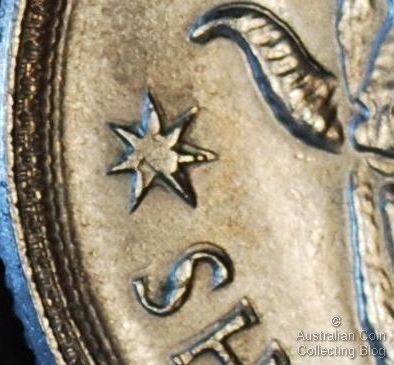 Reverse letter doubling, doubling on top of horn and star distortion due to the second strike
Reverse letter doubling, doubling on top of horn and star distortion due to the second strike Obverse letter distortion and rim beads smeared outwards during the second out of collar strike
Obverse letter distortion and rim beads smeared outwards during the second out of collar strikeIn 2010 the Royal Australian Mint continued with releases of the standard 25mm, 9 gram, aluminium bronze one dollar coin into both circulation and NCLT issues. All releases feature the standard Ian Rank-Broadley effigy of Queen Elizabeth II except one, the gold issue this year features the Vladimir Gottwald obverse previously seen only on the 2000 Royal Visit 50c. There was a release into circulation, a commemorative issue for the Centenary of the Girl Guides. These Girl Guide dollars were also available in commemorative RAM wrappered Rolls.
2010 continued with the idea of differentiating mintmark issues with mintmarks, counterstamps and privymarks. The RAM has even dusted off their mobile press last seen in 2008 to strike a C counterstamp at the Canberra ANDA show. They also specifically produced each privymark (and C mintmark) in one convenient 4 coin set and H,A,D and P privy's also in a 4 coin set and show special releases were pre-struck silver proof commemoratives for 100 years of decimal coinage. The "Master" term in reference to the mintmark and privy mark on these silver proofs refers to the kangaroo.
| Year | Description | Type | Mint Mark | Composition | Notes | Mintage |
| 2010 | Mob of Roos | Circulation | None | AlBr | Circulation | 20,595,000 |
| Centenary of Girl Guiding | Circulation | None | AlBr | Circulation | 12,585,000 | |
| Centenary of Girl Guiding | Circulation | None | AlBr | RAM Roll | 7,499 | |
| Centenary of Girl Guiding | Circulation | None | AlBr | PNC | 23,000 | |
| Centenary of Coinage | Circulation | C mm | AlBr | 4 coin unc set | 30,990 | |
| Centenary of Coinage | Circulation | S privy | AlBr | 4 coin unc set | 30,990 | |
| Centenary of Coinage | Circulation | B privy | AlBr | 4 coin unc set | 30,990 | |
| Centenary of Coinage | Circulation | M privy | AlBr | 4 coin unc set | 30,990 | |
| Centenary of Coinage | Circulation | C mm | AlBr | RAM Gallery Press | unknown | |
| Centenary of Coinage | Circulation | C mm, S, B & M privy | AlBr | 4 coin unc set Brisbane Coin Show Overprint | 600 incl in above mintage | |
| Centenary Coinage | Circulation | C mm | AlBr | PNC | 25,600 | |
| Centenary of Coinage | Circulation | H privy | AlBr | 4 coin unc set (2) | 20,001 | |
| Centenary of Coinage | Circulation | A privy | AlBr | 4 coin unc set (2) | 20,001 | |
| Centenary of Coinage | Circulation | D privy | AlBr | 4 coin unc set (2) | 20,001 | |
| Centenary of Coinage | Circulation | P privy | AlBr | 4 coin unc set (2) | 20,001 | |
| Centenary of Coinage | Circulation | C Counterstamp | AlBr | Canberra ANDA Mobile Press | 4,970 | |
| Centenary of Coinage | Proof | C mm | .999 Silver | Silver Proof Interrupted Reeding | 9,046 | |
| Centenary of Coinage | Proof | C Master Mintmark | .999 Silver | Canberra ANDA special release | 2,000 | |
| Centenary of Coinage | Proof | S Master Privymark | .999 Silver | Sydney ANDA special release | 2,000 | |
| Centenary of Coinage | Proof | B Master Privymark | .999 Silver | Brisbane ANDA special release | 2,000 | |
| Centenary of Coinage | Proof | M Master Privymark | .999 Silver | Melbourne ANDA special release | 2,000 | |
| Centenary of Coinage | Proof | P Master Privymark | .999 Silver | Perth ANDA special release | 2,000 | |
| Fred Hollows | Circulation | None | AlBr | RAM and Dealer Sales | 32,649 | |
| Year of the Tiger | Circulation | None | AlBr | Lunar Coin Series | 23,915 | |
| Year of the Tiger | Circulation | None | AlBr | Corporate Order | 3,200 | |
| Year of the Tiger | Proof | None | .999 Silver | Lunar Coin Series | 3,900 | |
| Burke and Wills | Circulation | None | AlBr | 2 Coin Unc Set | 40,000 | |
| Burke and Wills | Proof | None | AlBr | 2 Coin Proof Set | 9,995 | |
| Dorothy Wall | Circulation | None | AlBr | Blinky Bill Baby Mint Set | 33,131 | |
| Mob of Roos | Circulation | None | AlBr | Mint Set | 48,489 | |
| Mob of Roos | Circulation | None | AlBr | World Money Fair Mint Set | 2,500 | |
| Mob of Roos | Proof | None | AlBr | Proof Set | 18,313 | |
| Mob of Roos | Proof | None | AlBr | Blinky Bill Baby Proof Set | 10,002 | |
| Mob of Roos | Proof | None | AlBr | Wedding Set | 2,493 | |
| Mob of Roos | Proof | None | .999 Silver | Fine Silver Year Set | 2,040 | |
| Mob of Roos | Proof | None | .999 Gold | Ram and Dealer Sales | 450 |
If you've spent any time at all on one of the many internet coin forums then you'll almost certainly have seen the question 'I am a new coin collector, where should I start?'. There's dozens of tips that people give those new to the hobby, and you're probably well aware of most of them. So, just to change things up a little we thought we'd list off some things that the new coin coin collector shouldn't do when they are just entering the hobby. We'd love to say that we didn't do any of the things we're about to talk about but to be honest, we did most of them, and it's from this basis of hard experience that we speak.
1) Not spending the time learning to grade. Grading is without doubt the single most important skill a coin collector can possess.
2) Buying coins before the books or not spending sufficient time learning the hobby before handing over your money.
3) Diving in an buying a lot of low grade coins without any understanding of grading or what collecting theme the new collector is following.
4) Buying coins off of the internet or from dealers and blindly trusting the seller's grading.
5) Knowingly buying problem coins without realising the ongoing problems these will cause your collection.
6) Unknowingly buying problem coins.
7) Expecting to make money from the hobby immediately, lots of new collectors think it is a money making game rather than a hobby.
8) Improperly storing or handling a new collection. This can wipe much of the value of your collection off in just a few minutes.
9) Spending up big on mint issued NCLT and expecting it to increase in value in the short term. If you enjoy it, collect it, but making making money from NCLT is a tricky business.
All of the above points can impair the profits you'll make from collecting or put a dampener on your thrills in collecting. We get a lot of questions from novice or beginner collectors and even those who have simply found an interesting coin and want to know more about it. If we can set just one person on the right path or give them the tools to make the right choices then we've done a good deed in numismatics today :)
Last weekend was the Sydney ANDA Coin and Banknote Show at the Royal Randwick racecourse in Sydney (Saturday 14th and Sunday 15th of August). We usually give readers fly on the wall details about the going on at these shows (including the previous Melbourne show) but this, our first trip to the Sydney show was a fleeting one.
Randwick racecourse was easy to find with help from the GPS. We drove up the Sydney on Friday which allowed us to stay in the city and visit some coin shops in the city that we knew wouldn't be attending the show. The show opened at 10am the next day and we arrived about 10 past hoping to avoid a wait in line. Getting in was quick and easy with security and entrance officials lovely and polite and friendly.
Similar to Melbourne, the Sydney venue is a function room/bar used for racing events. A vast expanse of light coming through the windows with plenty of room for the dealers tables it was a comfortable venue for the event.
Many well known dealers had their usual tables including Waterman's Coins, Prospect Stamps and Coins, Downies, Sterling and Currency, VP Coins, Monetarium Adelaide, Rare Coin Co, John Eccles, Klaus Ford Numismatics, Edlins, JPW Coins, IAG and International Numismatics just to rattle off a few.
A few less often seen dealers of note were Drake Sterling, Ye Olde Coin Co and At the Toss of a Coin.
A notable absence was Renniks so those hoping to stock up on supplies headed on over to the At the Toss of a Coin table which was selling our own The Purple Penny Coin accessories. We helped Gerry McGinley at this table for most of the day on Saturday chatting to visitors and catching up with coin friends and online customers.
Saturday was very busy with hardly a chair to be had to sit down and browse dealers tables until after about 2pm when it quietened off a bit. Some dealers made a lot of sales whilst for others the whole event was a bit slow. The fees to have a table at the show are quite high and it can be very difficult for smaller dealers to simply make costs at these ANDA shows. By 4:30 the day was well and truly over (doors didn't close until 6pm) and some delaers went next door for a bit of a punt on a horse race. We were, after all, at the racecourse! A win on the horses was enough for some dealers to cover costs that weren't made from sales.
The Perth Mint and The Royal Australian Mint were in attendance and both were selling special show issues. When I asked the RAM assistant if the show special was the S over kangaroo privy mark silver proof dollar I got a blank look and he proceeded to open up the coin box to see. I managed to teach him about his own product that he was selling!
As with the other shows this year ANDA provided guest speakers including Rob Jackman (Rare Coin Co), Andrew Crellin (Sterling and Currency), Bron Suchecki (The Perth Mint) and Mark Van de Slys (CEO of Bullionmark) discussing investing and trading for wealth. One might have to put some thought into speaking at the next show about Collecting for Fun and the enjoyment of coins without breaking the budget.
We're sorry that we cannot comment on day two of the show as we had other commitments and a long drive hime. Overall a fun time was had with a few bargains found and purchased.
 2010 100 Years of Australian Coinage Made to Order Coin
2010 100 Years of Australian Coinage Made to Order CoinEach year the Royal Australian Mint releases a coin with a mintage decided completely by consumer demand. The coin must be ordered beforehand and only those coins ordered will be minted. This was previously known as the "Subscription coin" for the year but this year was remamed to the "Made to Order Coin". This name change was to reduce customer confusion over the details of the coins' production. Customers needed to order and pay for the coin upfront before it was struck in the numbers only for those who pre-ordered.
This years Made to Order coin celebrates the Centenary of Australian coinage with a total mintage of 4,975 coins. It is a 99.9% fine silver 40mm proof coin with an Australian legal tender value of one dollar. Issue price was $75.
The design was developed in collaboration with the Queensland branch of the Australian Numismatic Society and Royal Australian Mint designer Wojciech Pietranik. It features replications of the first four coin designs, the threepence, sixpence, shilling and florin first minted in 1910.
The obverse features both the current effigy of Queen Elizabeth II by Ian Rank-Broadley and the original effigy of Edward VII by George W de Saules. The reverse of the Made to Order coin features the Australian Coat of Arms by W H J Blakemore shown on all the first Commonwealth silver coins from 1910.
This coin celebrates those designs originally depicted on our commonwealth coinage different to the other $1 coin released by the RAM this year depicting all four monarchs in profile that have appeared on our coins.
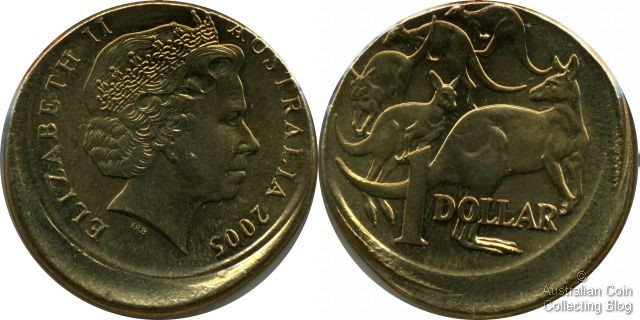 2005 $1 Mistrike pulled straight from a Security Bag
2005 $1 Mistrike pulled straight from a Security BagWe've recently discussed how new coins are handled and distributed from manufacture at the Royal Australian Mint through processing at the security companies and then delivery to clients such as banks and supermarkets. Based on these processes we're now able to discuss how manufacturing errors might be released into circulation or how they might be caught up in the system.
For bulk circulation coinage once the coins leave the coining press there are no processes for quality control to find any imperfect or error coins before leaving the Royal Australian Mint.
It's up to security companies who handle the bulk coin to "come across" any problem coins in the system. This is much easier with coin rolling machines as any coins of incorrect shape or size are quickly fed into a reject box and the system continues to operate.
With the batcher machine (explained in the previous article) which feeds the coins into bags a mistruck coin will stick onto the rail of the batcher. The machine ceases to run but as the operator opens the door the coin may just run into the small bag because the belt continues to move momentarily. Once the bags are sealed there are no other checks (except for the odd bag that is weight/face value checked) and the coin will happily pass into circulation. Is this how the dramatically double struck $2 coins passed into circulation?
The weights of new coins are a huge headache for security companies. The manual checks of the weights of the bagged new coins can differ dramatically. One dollar coins can often weigh somewhere between 8 and 9 grams when 9 grams should be the exact weight. This can escalate into 60 grams per $100 and then 6-8kg per pallet which is a 6% error rate. Not acceptable when you're talking about money! This is the result of poor quality blank manufacturing procedures at the factory who the RAM buys their coin blanks off, Poongsan in South Korea. We've seen mistakes that have originated from there with a one dollar coin passing through the system into circulation.....struck on a bimetal planchet!
If the problem coins are detected in these processes what happens next? Well if they aren't appropriated by staff or sent back to the RAM then they are sent interstate to a company which refunds the security company the Australian dollar equivalent or the scrap metal equivalent. This company still receives 1c and 2c pieces which are paid approximately double the face value for their copper content.
So it's really looking quite promising that on your next trip to the supermarket you could be heading home with a mistruck coin in your pocket!
Have you evern wondered how our new coinage is distributed after it is manufactured at the Royal Australian Mint in Canberra? How does it end up in your purse or wallet?
Newly struck brilliant uncirculated coins leave the presses and accumulate into 44 gallon drums. These drums are manoevered through the mint facility by AGV's (automated guided vehicles) which make light work of coin handling. This is the end of the Mint's involvement with the new circulating coins, they are shipped off in these 44 gallon drums to security companies such as Armaguard.
At the security companies these new coins are loaded into a huge coin hopper. Depending on what denomination is being processed up to 4 of these 44 gallon drums may fit into these huge hoppers. This hopper then trickle feeds the new coins into 6 coin batchers that counts out the specified amounts and then drop them into a small satchel bagger. The small bags drop out the bottom onto an elevator which runs onto a conveyor into a big bagger. The big bagger seals the larger bag of multiple small bags and sends it to the check weigher. These bagged coins will then be opened up and manually counted to check the quantities are accurate. Any weight difference can then be allowed for, or the check weigher adjusted to the accurate weight for this batch of coins. These big bags are then dumped into big bins. This process can produce 300 bigger bags of 25 smaller bags ($100 x 20c bags) in an hour. The majority of new coins are processed this way into sachets. Companies such as Woolworths and Big W require their change to be delivered in sachets and not into rolls anymore. Coles have systems in place favouring rolled coin. So what happens next? Armaguard, Brinks or other security carriers delivers the new coin to their clients such as supermarkets and banks in manageable weights.
$2 = $50
$1 = $20
50c = $10
20c = $4
10c = $4
5c = $2
And what happens to those empty 44 gallon drums now? Well just in case you're interested some are sold to a bio-fuel company to collect waste cooking oil at the back of restaurants and takeaways!
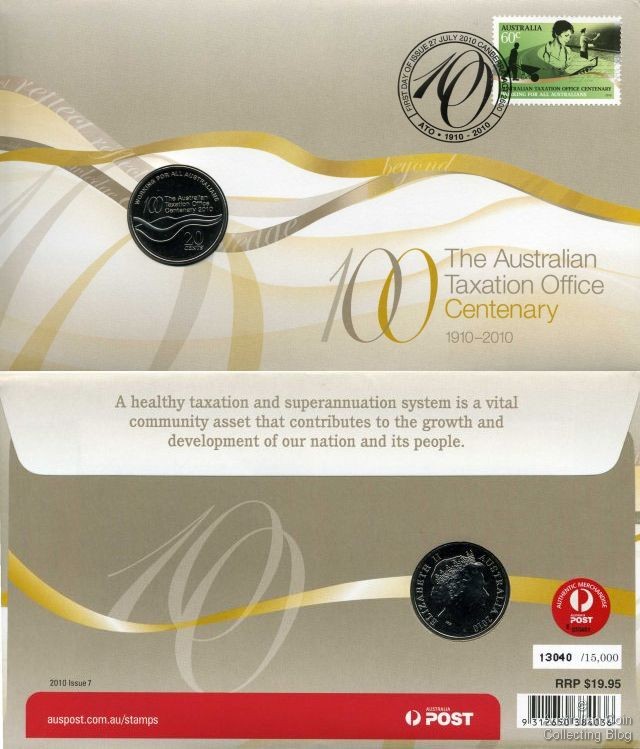 2010 20c PNC Centenary of the Australian Tax Office
2010 20c PNC Centenary of the Australian Tax OfficeWhat we now know as the ATO the Australian Tax Office was formed in 1910 beginning as the Land and Tax Office in the Commonwealth Treasury. This department was initially established to fund invalid and old age pensions. 100 years later we reflect on it's achievements with a comemmorative 20c issued by the Royal Australian Mint. The centenary officially occurs on November 11th but with respect to Remembrance Day celebrations will take place on November 12th 2010. A program of events continues throughout 2010 including a book release and also the recognition of Women in the ATO on International Women's Day in March 2010.
Media originally reported approximately 5 million 20c piece* will be released into circulation so expect to find one of these in your change soon. The reverse design "Working for all Australians 100 The Australian Tax Office Centenary 2010 20 cents" was designed in collaboration with the Australian Tax Office and the Royal Australian Mint designers. The obverse is the standard Ian Rank-Broadley portrait of Queen Elizabeth II.
The PNC released by Australia Post is just one release in a series of stamps and first day covers. It features one 60c stamp postmarked in Canberra 2600 on the date of issue July 27th 2010. This PNC is limited to 15,000 and each cover is uniquely numbered. Released for $19.95 this issue will be highly sought.
* actual circulation mintage 11,575,000.
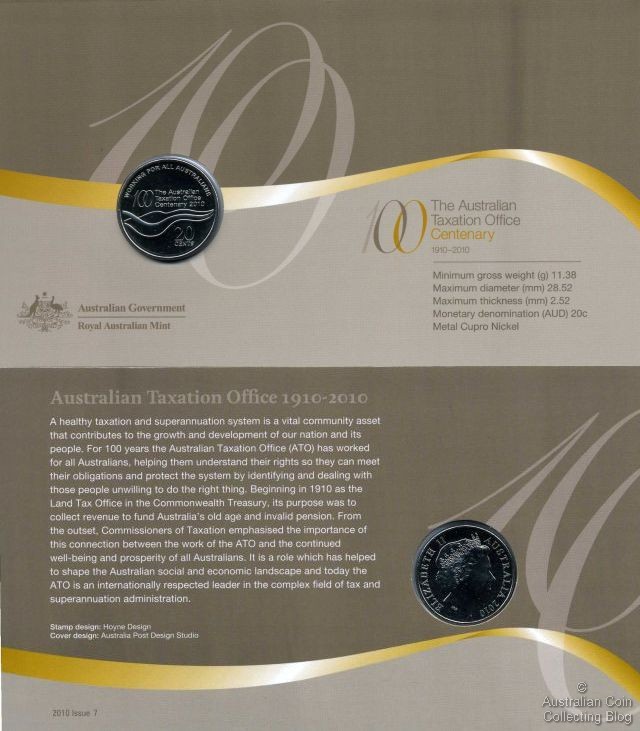 2010 20c PNC Centenary of the Australian Tax Office -insert
2010 20c PNC Centenary of the Australian Tax Office -insert
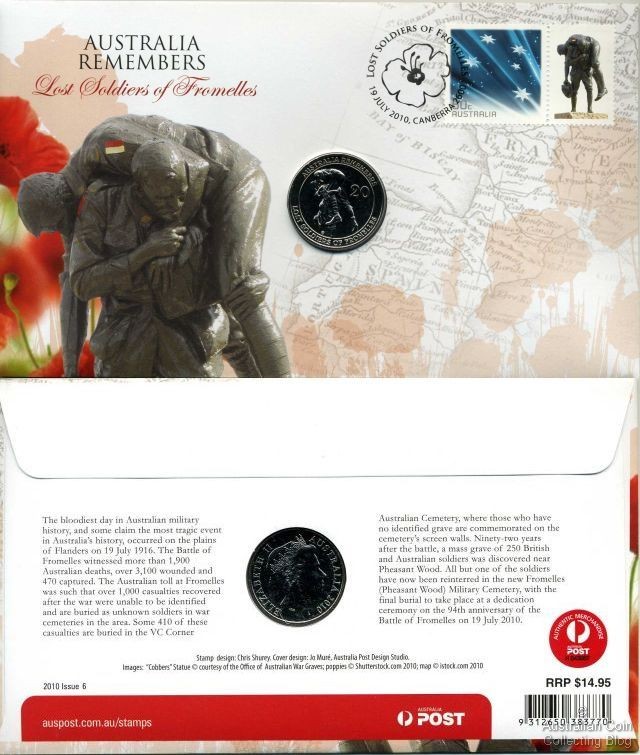 Fromelles PNC
Fromelles PNCReleased on July 19th 2010 by Australia Post (in partnership with the Royal Australian Mint and the Australian Fromelles Project Group) this PNC features a comemmorative 20c remembering the lost soldiers of Fromelles. The PNC also features a 60c stamp alongside a picture of the statue of the "Cobbers" that the coin also depicts. Postmarked 19th July 2010, the 94th anniversary of the battle this PNC was released for $14.95. The last unknown soldier was buried at the new Fromelles (Pleasant Wood) Cemetary in a dedicated ceremony on that 94th anniversary.
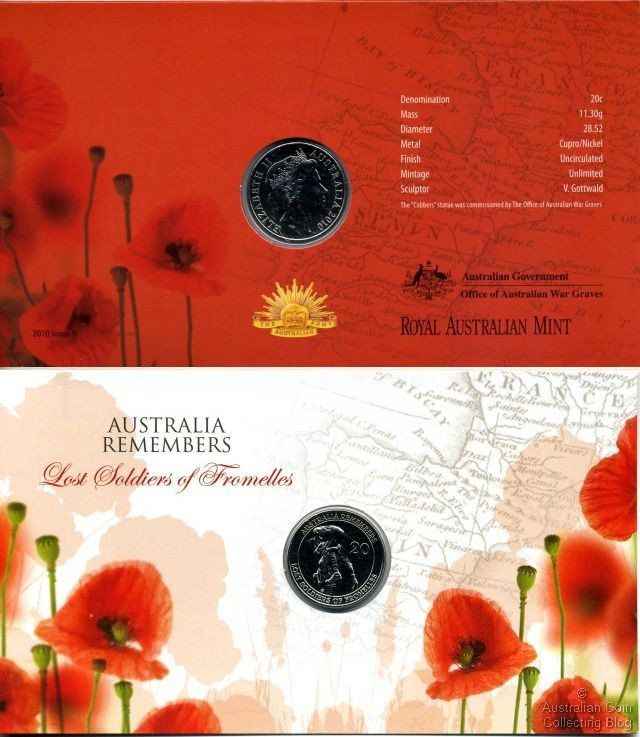 Fromelles PNC insert
Fromelles PNC insert

